In the 1930s, the Italian military (like all major military forces at the time) was investigating options for a semiautomatic service rifle. Beretta’s Tulio Marengoni developed one such rifle, and submitted it in two forms.
The first version of the rifle was produced in 1931, chambered for the then-standard 6.5x52mm Carcano cartridge. It was a short-recoil action with a rotating bolt, and fed from standard 6-round Carcano en bloc clips.
The second version was produced in 1937, after the Italian military had adopted the 7.35mm cartridge. The 1937 version was made slightly shorter and had a simple fixed rear sight (both changes similar to what would be made for the M38 Carcano rifles). The 1937 Beretta also used a new magazine system, fed by stripper clip. The capacity it not clearly known; Riccio states 9 rounds with a specialized clip. This would make some logistical sense, as a standard 18-round box of Carcano ammo would evenly fill two 9-round clips. However, it seems plausible that it might also have been a 10-round magazine with two 5-round clips, in line with what was typical elsewhere in the world. Finally, the 1937 rifle included a locking mechanism that could be used to prevent the barrel from recoiling, and thus turn the rifle into a manually-operated one instead of a self-loader. It is interesting that such a device was requested on the later model rifle, but not the early one. Perhaps it was based on accuracy concerns, or being able to fix the barrel in place for bayonet use?
The internal mechanism was quite novel. The very large firing pin spring actually served both to prevent slamfiring when the bolt closed and also provided the force to rotate the bolt into battery. This is typically done with a linear return spring pushing the bolt lugs against some typic of cam that forces them to rotate, but Marengoni’s design instead winds that firing pin spring rotationally and allows it to put direct rotational pressure on the bolt. Unlocking is, however, done by a rounded cam surface that the bolt handle stem contacts as the whole barrel and bolt assemble moves backwards. This camming surface forces the bolt handle up, unlocking the lugs.
Disassembly is a very simple process: unscrew the rear receiver cam and pull everything out. The cap is locked in place by the bolt release catch on the 1931, and by the ejector assembly on the 1937.
Ultimately the Armaguerra model 1939 was the winner of the extended Italian military trials, but World War II interrupted any plans to put it into mass production.
Beretta Model 1931
Notable characteristics:
- Full-length wooden stock
- 24.8 inch (630mm) barrel
- 9 pound (4.1kg) weight
- Straight wrist
- 6.5x52mm
- Feeds from 6-round standard Carcano clip
- Short recoil action
- Front end of barrel fluted
Beretta Model 1937
Notable characteristics:
- Metal front handguard
- 21 inch (533mm) barrel
- 8.9 pound (4.0kg) weight
- Semi-pistol grip wrist
- 7.35x51mm
- Feeds from 9-round fixed internal magazine (stripped clip fed)
- Short recoil action
- Smooth barrel profile

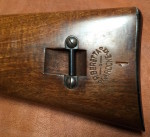


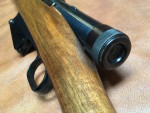









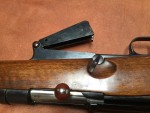




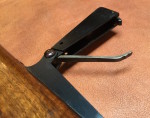






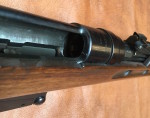
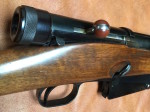
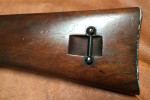






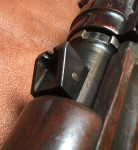


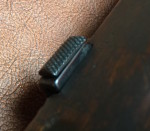



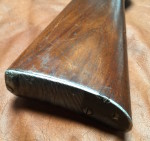
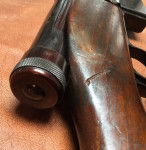






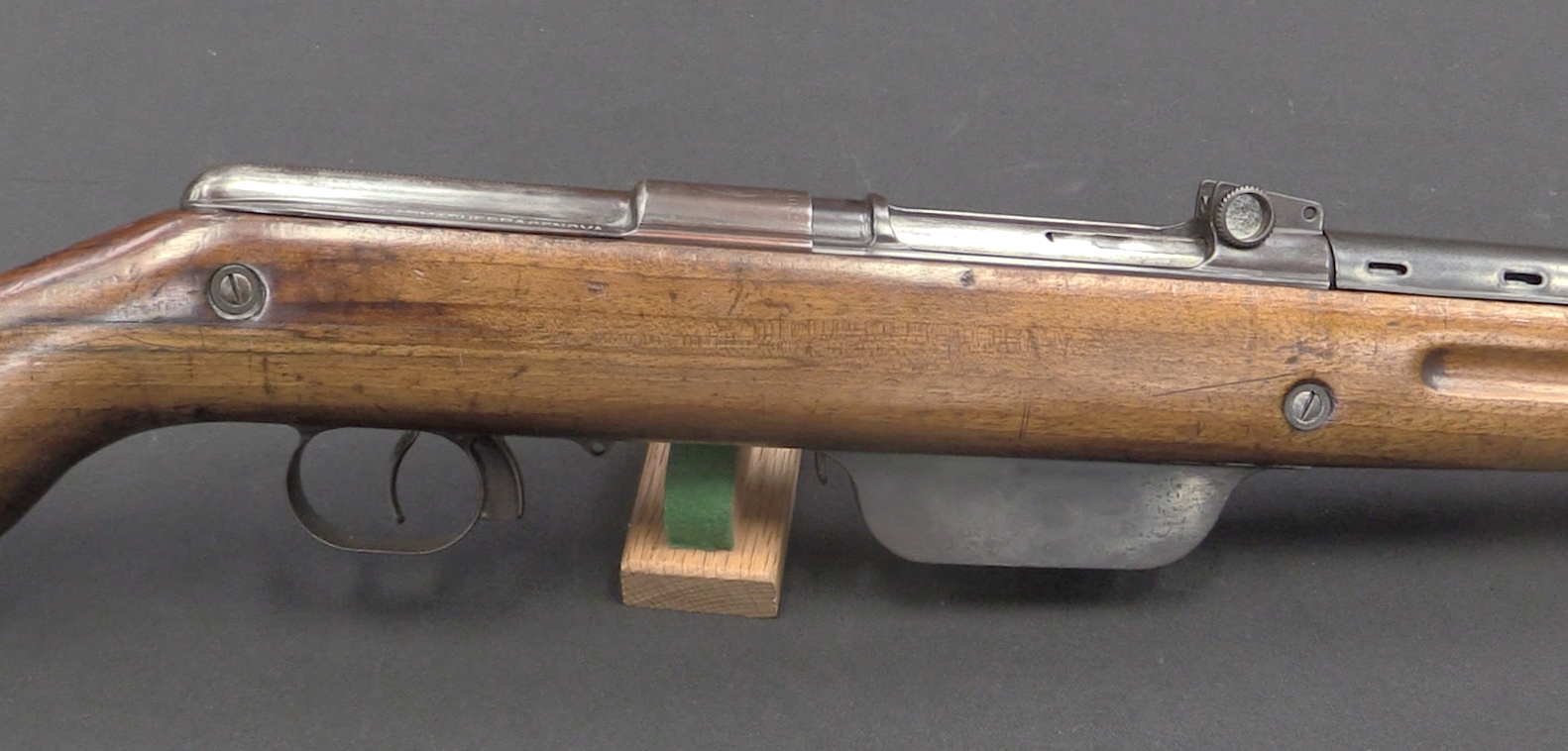
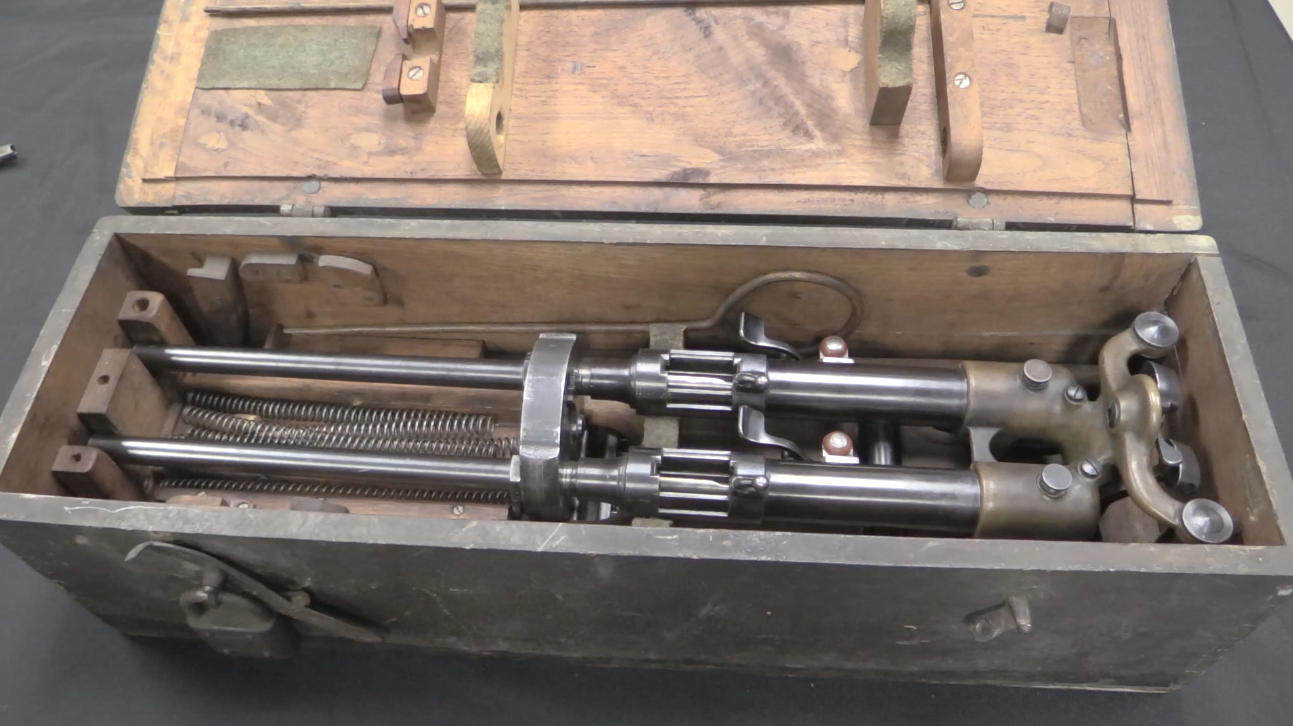
Wow! thanks,
The Beretta SMG heritage is clearly visible. and to a slight extent the Villar Perosa heritage
Apart from recoil operation (and probably some fairly harsh recoil considering the small rounds) The Italians were there with almost intermediate rounds before almost anyone else. The 6.5mm was intermediate and way ahead of its time.
They’re way simpler than a Feyoderov Avtomat as well.
The plum / mahogany coloured finish on the later rifle is interesting
Did the Beretta guys say anything about that? was it a temper finish or did the hot bluing bath object to a nickel steel?
could the metal fore end have been partly to adjust the balance of the gunm as well as to provide a surface for use in bayonet fighting?
With dissimilar metals, the softer metal only wears under perfectly clean conditions, as soon as dirt gets in there, it embeds in the softer metal and the harder metal gets worn.
“The 6.5mm was intermediate and way ahead of its time.”
In fact I found change from 6.5mm to 7.35mm as totally wrong and even worse – ill timed, it also delayed production of mentioned Armaguerra self-loading rifle due to change in caliber and do logistic fuss.
The official story is that the Italian Army thought the 6.5mm was “insufficiently lethal”, so they wanted a heavier caliber. At about the same time, the Imperial Japanese forces were going from 6.5 to 7.7mm in the Arisaka rifle and etc., apparently for the same reason, so there may be some truth to this.
Another version is that the Italian Air Force wanted the heavier round for the machine guns in their fighters and bombers. This is also possible, and the two explanations are by no means mutually exclusive.
The Regia Aeronautica had a very realistic view of what sort of guns you wanted on combat aircraft; one of their favorites was a modified copy of the U.S. Browning .50 that showed up as both a fixed gun (for instance, on the Macchi C.202 Folgore [Thunderbolt] fighter) and a flexible gun (for just one example, on the upper open mount of the Savoia Marchetti SM.79 Sparviero [Sparrowhawk] medium/torpedo bomber).
The difference was that their version used the 12.7 x 81mm Vickers HMG round instead of the 12.7 x 99 BMG; this allowed them to build it a bit lighter and with a slightly shorter receiver. It still got the job done at the receiving end.
(NB: Anybody who thinks that Italian fighters and bombers of the war years were jokes never tangled with one. Especially not that nasty b******d the SM.79. The RA had some excellent combat planes and their pilots were aggressive as H**l. Put it this way; the Luftwaffe thought they were crazy.)
Although if the RA wanted more wallop from their “rifle-bored” MGs, it would have been easier to just adopt the 8 x 59 round used in the Fiat/Revelli 14/32 heavy MG that was later used in the Breda Model 1937. This powerful round had nearly the ballistics of the .300 H&H Magnum African game cartridge, and would certainly have had all the punch and range you could ask for in a nominally “rifle caliber” MG cartridge.
A fighter like the Reggiane Re.2000 Falco (Falcon) armed with 8 x 59 MGs would not have been a pleasant surprise for Allied forces in North Africa or the Med.
cheers
eon
Well, the Fiat G.55 Centauro was a VERY nasty surprise for B-17’s. It had two 12.7 mm Breda SAFAT machine guns and 3 Mauser MG 151/20 cannons as the primary armament. The Centauro had a very good climb rate and large wing area (which meant it could outdo the Macchi C.205 above 8000 meters) and a very large ammunition capacity (compared to that of the Reggiane Re.2005 Sagittario), so I’m pretty sure NOBODY wanted to be the ball turret gunner staring into the face of a Centauro pilot! 2 .50 Browning HMG’s versus 2 SAFATs and 3 MG 151/20’s. Which would win in a face to face duel?
The 7.35mm is *less* powerful than the 6.5mm and fired a considerably *smaller* (lighter) bullet. Here’s some figures:
6.5mm – 10.5g at 700 m/s giving 2580 J of energy.
7.35mm – 8.4g at 756 m/s giving 2400 J of energy.
The 7.35mm case was just a 6.5mm case necked out and made 1mm shorter.
The 6.5mm was a round nosed bullet, while the 7.35mm was a spitzer (pointed) bullet. The move to 7.35mm from 6.5mm may have had more to do with trying to get back some of the bullet mass which was lost in changing the shape and construction of the bullet while keeping the overall size and shape of the rest of the rifle the same. Supposedly, they intended to convert their existing rifle stockpiles by just re-barreling them (some claim by re-boring them) and changing the sights.
The main practical difference in the rounds is that the 7.35mm bullet had increased lethality due to an increased propensity to tumble after striking the target as compared to the older round nosed one.
All true, but remember that a lot of people then and still today equate “bigger bore” with “more stopping power”, irrespective of physics.
It’s a reversion to blackpowder ballistics. Back then, since the upper limit on velocity was about 800-900 f/s for pistol length barrels and under 2000 f/s for rifle-length ones, the surest way to increase muzzle energy was to launch a heavier bullet, which required a larger bore diameter in most cases.
(Ex; Colt 1860 Army .44 and 1861 Navy .36 revolvers, both at 700 F/S muzzle velocity. .44 with 135 grain ball, .36 with 85 grain. .44 ME 147 FPE, .36 93 FPE.)
When smokeless powder came along and even pistol muzzle velocities broke the sound barrier, velocity squared superseded bullet weight as the main generator of hitting power. But a lot of people still go by the older “bigger hit=harder hit” formula, even today, let alone in the 1930s.
It’s like the idea that the .45 ACP is a better “stopper” than the 9 x 19mm. If you go by modern U.S. MILSPEC loadings, the 9 actually comes out on top; 124 grain at 1300 for 465 FPE, vs. 230 grain at 900 for 405 FPE. It’s the difference between a “warm” .357 Magnum and the old .45 Long Colt “cavalry” load circa 1880.
In fact, using WW2 issue loads, the .45 ACP, 9 x 19mm, and 7.62 x 25mm all come out about even in ME (about 350 FPE apiece), but the 7.62 and 9 have it all over the .45 in penetration. Small and fast beats big and slow.
As for bullet “tumbling”, all bullets “tumble” inside the body cavity- even pistol bullets. Because stability in air and stability in a semiliquid/solid medium require the mass of the projectile to be in different places relative to axis of travel; in back in air, in front in liquid/solid.
Generally, bullets like rifle bullets (ogive/spire point, 2:1 or greater length/beam ratio) turn over once, and continue rear end foremost. (Note the resemblance of a boat-tail, spire-point bullet to the “teardrop” hull of a high-speed nuclear fast-attack submarine in this context.)
Pistol slugs turn over once, and continue flat base forward.
Some bullets with abnormal L/B ratios or unusual shapes and mass distribution start to tumble and never restabilize, turning over and over and creating horrendous wound channels. The old 200-grain bullet in the .380in Webley revolver, the U.S. 200-grain “Super Police” load in the .38 Special, and the 6.5mm Carcano bullet all exhibit this behavior. Yes, the 6.5 x 52 Carcano’s bullet generated worse wounding effects that the 7.35 that replaced it.
The 6.5 had originally been designed to use a bullet with a forward core made of soft aluminum, to make it deform more readily on impact. (They were thinking of shooting at natives, as in Abyssinia.) The Hague Accords put paid to that, so the Italian Army developed the 7.35 round to “restore” the wounding power they thought they’d lost. Never realizing that the 6.5 bullet’s long, skinny profile was what did the actual damage, not their tricky bullet core setup.
“Wound ballistics” is considered a “dark art” by a lot of people, but it really isn’t. It’s just a case of understanding the physics involved.
And the physics change radically at the “interface” between the open air…and a body.
I know because I’ve looked inside more than a few bodies at post mortems. Looking for bullets.
It was a nasty job, but it was unfailingly interesting.
cheers
eon
“7.62 x 25mm”
This cartridge was choice, because was optimal for sub-machine gun from available cartridges. Tokarev automatic pistol is in fact side-effect of sub-machine gun development.
Tokarev tried to make sub-machine gun for 7.62x38R Nagant cartridge – Пистолет-пулемёт Токарева ППТ:
http://www.dogswar.ru/oryjeinaia-ekzotika/strelkovoe-oryjie/4062-pistolet-pylemet-tok.html
it was produced in small numbers (~300 – ~600), it anyway special variant of 7.62x38R cartridge so it was decided that future sub-machine guns and automatic pistols will fire 7.63×25 Mauser cartridge.
“Italian Air Force wanted the heavier round for the machine guns”
Hasn’t Regia Aeronautica own supply chain? If they have they should can use own cartridge without causing much trouble.
“At about the same time, the Imperial Japanese forces were going from 6.5 to 7.7mm in the Arisaka rifle”
Red Army default cartridge (at least formally – in fact total mix of produced, bought, donated and captured ammunition was used) was 6.5 Japanese – few years in early 1920s, later return 7.62x54R was caused due to better penetration (then used tanks and armored cars has armour thin enough to be penetrable by AP bullets from rifle), better tracer (-T in US parlance) and HE (used in aviation) bullets.
“It [Breda-SAFAT] still got the job done at the receiving end.”
https://it.wikipedia.org/wiki/Breda-SAFAT states that:
“Questo armamento si dimostrò inadeguato nei primi anni di guerra e si ricorse quindi all’adozione del cannone tedesco Mauser MG 151/20 da 20 mm, installato sino a ben 3 pezzi sui nuovi caccia Macchi M.C.205, Fiat G.55 e Reggiane Re.2005(…)”
Which (if I understand correctly) means:
“This wepaon [Breda-SAFAT 12.7mm] demonstrated inadequate performance in early year of wae, which lead to adaptation of German Mauser MG 151/20 cannon, installed in quantity of 3 in new pursuit planes: Macchi M.C.205, Fiat G.55 and Reggiane Re.2005(…)”
1. The RA was originally part of the Army, and as such was stuck using the Army’s logistics train.
2. The 12.7mm was considered inferior to the guns they were facing early in the war. Namely those of the British Royal Air Force, which were mainly 20mm Hispano cannon firing explosive shells rather than solid slugs.
3. Most European air forces installed guns in fighters in pairs or at most quartets. Two in the engine cowl and one in each wing was typical. RA instalation followed German practice, just like this.
The RAF preferred to avoid cowl guns (to avoid synchronization issues with the spinning prop) and installed pairs or quartets of cannon in wings, backed up by quartets or even sextets of rifle caliber (0.303in) MGs. (Spitfire “E” Wing; 1 20mm cannon, 1 12.7mm BMG, two 0.303in BMG in each wing. Total; 2 cannon, 2 .50 HMG, 4 .303 MG per fighter. NB; the .50s were often “pulled”, so that the space for them and their ammo trays could be used for more ammo for the 20mms. This effectively doubled the ammo supply for the cannon.)
You can see why even 12.7mm SAFAT MGs looked “inadequate” compared to that sort of arrangement. To say nothing of a Hurricane II (12 0.303in MGs) or IV (4 20mm Hispanos plus 6 0.303in).
Then of course the Americans showed up, and demonstrated their definition of how to mount “fifties” in a fighter. Six wing-mounted .50s in a P-40E or P-51D, eight in a P-47 (any version).
By that time, Italian fighters were mounting 20mms, but again only in pairs. And once more ended up on the short end of a firepower imbalance.
NB; after 1943-44, the Italian Co-Belligerent Air Force (ICBAF) got its first American fighters. They were P-39Q Airacobras, and they were overjoyed to get them, even with the P-39’s less-than-sterling reputation. (Much of it based on myth, not facts.)
One 37mm cannon firing through the prop hub, backed up by a pair of .50s in the forward upper decking and two more under the wings, looked like a Juggernaut by their standards. And compared to their usual gun fits, it pretty much was.
cheers
eon
The 6.5 round was not found to be insufficiently lethal, but insufficiently incapacitating, and unnecessarily heavy.
the 7.35 round, being lighter, and so faster, had a flatter trajectory in the first 300m, where it counts (post WWI studies of the Italian Army showed that 90% of rifle shootings were aimed a targets that were at less than 100m, and 99% at less than 300m). A flat trajectory round was better suted for a rifle that had a fixed sight adjusted at 200m, good to hit a human sized target from 0 to 300m simply aiming at the centre of the torso.
The 7.35 round, other than being a spitzer, had an aluminium tip and a lead bottom, so it was made to easily tumble inside of the body, rendering the wounds it caused more incapacitating than those of the 6.5.
7.35 is exactly the diameter of the grooves of the 6.5 cArcano barrels. So the barrels for the new rifles could be made from millions of worn 6.5 barrels lying in the arsenals since the end of WWI, simply reboring and cutting them.
The Regia Aeronautica had a different supply chain. It used the 303 British from the IWW (since it mainly used the Lewis gun on the aircrafts) to the end of the IIWW (in the 7.7mm Breda SAFAT. The 7.7 round was the 303 Brit). When, at the end of the ’20s, they realized that the Aircrafts were becoming increasily impervious to rifle caliber rounds, they went to the 12.7X81, that was the .50 Vikers, developed in the early ’20s. At that time the Browning M2 was not even existing (The Breda SAFAT 12.7 and 7.7, was not a Browning copy. The only thing they have in common is the presence of an accelerator, that in the Breda was shaped differently anyway).
It’s difficult to understand today, when 20 years old fighter are still good for first-line service, but, in a 5 years span only, in the second half of the ’30s (moreover, a period of economic crisis), aero fighters developed from biplanes armed with a pair of rifle-calibre MGs, to metallic monoplanes armed with eight MGs, three cannons, and so on.
In this scenery, the nations that recognized first than the others the necessity of improving the firepower of their planes, risked to be outgunned by the last ditch efforts made by the others, literally few days before the outbreak of the war.
That’s the present case. Italy was one of the first powers in recognising the necessity of replacing the rifle-calibre MGs with heavier weapons. The studies for the 12.7mm Breda-SAFAT begun at the end of ’20s, the weapon was ready in the early ’30s, experimentally installed in some Fiat CR30, and standard in Fiat CR32 (first flew in 1933, in line in 1935).
Equipped with them, for example, the pilots of CR.32s (a fighter they already know had soon be replaced, and it was only two years old) that witnessed the brand new Bf109 B1, B2 and C in action in Spain 1937-38, could hardly have been impressed by their armament of two, three (whit the often-jammed third MG of the Bf109b2 making bad press to propeller-hub-firing weapons also) and four rifle-calibre MGs respectively.
In the end, still in 1938, a pilot armed with a pair of heavy machine guns, could think to be very well armed compared to his opponents. A year later, with the same armament he was outgunned.
We can see the same problem whith the other power that choose to rely on heavy MGs.
In 1936 the Grumman F3F entered in line armed with a 0.30 and a 0.50 Browning. In 1937 the P-35 had two 0.30 and two 0.50. So was armed the P-40 until the D Version (and, at that point, the war in Europe had already begun). Better than the Breda SAFAT couple, but not an impressive armament at all. But the U.S. entered the war later, and had the time, and the manufacturing capability, to use the European lesson.
“aero fighters developed from biplanes armed with a pair of rifle-calibre MGs, to metallic monoplanes armed with eight MGs, three cannons, and so on.”
And mostly importantly due to progress in building high-power but light engines newer pursuit (and not only) planes were significantly faster than older.
Speed proved by crucial in air warfare – see for example Heinkel He 51 and Arado Ar 68 which proved be inferior to soviet I-16 during Spanish Civil War.
“NB; after 1943-44, the Italian Co-Belligerent Air Force (ICBAF) got its first American fighters. They were P-39Q Airacobras, and they were overjoyed to get them, even with the P-39’s less-than-sterling reputation. (Much of it based on myth, not facts).”
By any accounts they hated them and considered them to be garbage. The aircrafts were worn up (they were the same precently used by the 332nd fighter group), of 170 delivered, 21 were judged not flyable nor repairable and used for spare parts only. The engines of the others had an operational average of 150 hours and should have been replaced. In action they proved to be prone to failure and plainly dangerous (Teresio Martinoli, one of the leading Italian aces, was killed by the engine of his P39 that failed at takeoff, other three pilots suffered the same fate). In flight, the stall charateristics were awful, with the stabilizer stalling before the wing itself in tight turns, and caused the death of some other. Furthermore Italian pilots were not used to carbureted engines that suffered negative G manuvers. Unfortunately, the Macchi C.202 and C.205 with which they had flown to the south at the armistice were too worn out in mid 1944, and any aircraft was better than no aircrafts.
The Aeronautica NAzionale Italiana (ANR) pilots were treated a lot better by the Germans. The Fiat G.55 was left in productin for some time after sept. ’43, and, when the production was stopped to rationalize the supplies, they were equipped with brand new Bf109K.
All in all, The Italians considered the C.202 to be roughly equivalent to the Spit Mk V and the Bf109F. The “5 series” fighter to be equivalent, or even better, than the Spit MK XI, BF109G/K and P47. The P51D come in numbers only in late 1944. It was part of another generation.
In Soviet service P-39 was generally judged positively, but with note that it was prone to flat spin. But it must be noted that VVS received brand new examples.
For completeness.
“One 37mm cannon firing through the prop hub, backed up by a pair of .50s in the forward upper decking and two more under the wings, looked like a Juggernaut by their standards. And compared to their usual gun fits, it pretty much was.”
Really it was nothing exceptional. The 37mm gun was almost useless in air to air combat, since it was too slow firing (150rpm), and with a low muzzle speed that gave to its bullets a completely different trajectory than those of the MGs. The “real” armament of the P-39 were the four .50 cal MGs, that were marginally better than the two .50 (with explosive bullets for them) and two .303 of the macchi C.202, and far worse than any of the “5 series” fighters, with two .50 and two or three 20mm guns.
With respect to what you say and others below (especially MG), it may be likely true IF cartridge designers were to choose long ogive instead of old semi-round form. Such bullet would be bit lighter and faster with more energy at the muzzle and maybe even better range. But as we know, history went the other way.
The 8×59 and the sinilar 8mm Bofors round in Sweden, were (with hindsight) far better contenders as HMG cartridges than any 7.35mm or 7.7mm rifle cartridge.
I think the complaints about the 6.5 arose as an excuse for the very rapid reversal and defeat of the Italian invasion of Abyssinia (Ethiopia).
Had it not been for Abyssinia, and the ostracism which the Mussolini regime suffered following it
Mussolini may have remained aloof to that little ill bred savage north of the Alps, and he may Mussolini may still have been held in the (IMO deeply mistaken) high regard that he was held in during the 1920s and 1930s.
The story still persists around Lago Di Como, that Mussolini expected to be flown to England, but was instead murdered by Churchill’s agent (to silence him) and the bodies dumped in a driveway entrance.
I have not gotten so far into study of this dastardly (Abyssinian) war, but with the amount of time passed, it is fair to say that Musso shot himself in foot.
BTW his and his fiance’s bodies were hung on frame of a pump station. http://www.custermen.com/ItalyWW2/ILDUCE/Mussolini.htm
The commies took it as their own job.
They bodies were found in the little private driveway entrance, about half way up the West side of Lake Como. There’s a black steel cross shaped plaque there now, I’ll look out one of my photos of it.
The Communists took the bodies to Milan and hung them upside down by the petrol pumps.
The locals up there tell the story that Mussolini and his mistress had a meeting with one of Churchill’s men, who silenced them instead of getting them to safe exile.
“I think the complaints about the 6.5 arose as an excuse for the very rapid reversal and defeat of the Italian invasion of Abyssinia (Ethiopia).
Had it not been for Abyssinia, and the ostracism which the Mussolini regime suffered following it”
?
In Ethiopia the Italians lost at Adua, in 1896. The 6.5 cartridge was not used then. The fresh troops that came from Italy, that had been already equipped with M91 at home, had them replaced with the Vetterli first to be sent in Africa, for standardization with the local troops.
The fascist invasion of Ethiopia in 1935-1936 was succesful, and Ethiopia was conquered and annexed in seven months.
I wish I knew why these videos are being blocked on FireFox lately. I can view the adds and I can view the videos on Youtube but for the last week I cannot watch anything but the adds by clicking the links.
In the past (I didn’t check this lately) Full30 was downloading the videos but just not playing them. So I just needed to locate the files in the browser cache, change the file extension, and then play them with a standalone video player software. Thankfully videos are now getting posted to the Youtube channel at the same time as Full30, so no more having to wait a few days (or weeks/months/etc) for them to show up on Youtube.
I had to go over to Full30 to view it as well.
Does that bolt head resemble the AR bolt head to anybody else?
To the extent that it has multiple lugs (8 of the little buggers) in order to minimise bolt rotation, yes.
Very nice design feature having the recoil spring telescope with the bolt to reduce receiver length.
Recoil operated rifles are rare breed and this one is exactly what I like to see. I had been intrigued with them for many years.
One observation however, more as point of debate: I have not spotted barrel return spring. Is it that barrel is pushed forward by main (bolt return) spring? If so, the main spring likely does the job quite well since barrel travel is short. Truth is that barrel goes forward already at time of chambering round.
My second point goes into principle question of whether and how to utilise available momentum present in moving parts. What I have on mind is absence of accelerator in this case, which would/could utilize this momentum to drive bolt. By doing so it would generate resistance to early bolt opening which in turn could be lighter. Overall, the action would work with greater timing leeway. On minus side it would certainly add complexity.
I am not claiming this is necessary, it is one of two and as I believe, the better option. With the system as it is, the bolt to move reliably back with sufficient energy present, it probably needs residual pressure which in turn leads to tight timing with no dwell. This is apparently what designer had on mind when creating this magnificent rifle(s) and such was his choice.
“Recoil operated rifles are rare breed and this one is exactly what I like to see.”
Can be recoil-operated rifle be used to fire rifle grenades? If not this might be explanation for its unpopularity in military applications.
Yes, the G3 and other H&K roller-locked rifles do it all the time.
The problem is that gas-operated rifles can be used by having a gas cutoff to keep the greater gas pressure from the grenade blank from getting into the system, over-pressuring it, and probably wrecking it.
The FAL has a gas valve cutoff, as does the M14. The M1 Garand has an automatic, spring-loaded gas valve vent that is pushed open by a nub mounted on the grenade-launching spigot that pushes it back when you attach the spigot and lock its little clamp on the bayonet lug.
The M16 just uses gas cartridges with low enough pressure to avoid wrecking the direct-gas system. (Theoretically; I’ve seen a few messed up by grenade firing done strictly “by the book”. Most often, either sheared bolt locking lugs or a cracked gas tube.)
In a recoil-operated system, you either have to have some way to lock the action to avoid it being slammed open violently by the recoil (as this one does), or just build it so brute-strong that it doesn’t matter. Which is what you see in the H&K rifles, the Swiss SG57/Sig SG-510 series, and similar “roller-locked” arms.
cheers
eon
Mecar of Belgium have pioneered “bullet trap” (basically soft steel plug) grenade which do not require to change gas setting, neither type of cartridge. This is not to say that pressure in entire length of barrel is not elevated in that case above what barrel sees in usual case. I do not have personal experience with shooting grenades via rifle, but I understand it is extraordinarily punishing for both the rifle and the shooter.
Regarding your note from 5:20 I want to say that I am thoroughly impressed by your treatise and agree with most if not all of your conclusions. If you are a surgeon in addition to being ballistician, your credits are indeed impressive.
I have conceptualised some time ago kind of hybrid ammo concept and I am wondering, if you were interested to give me your opinion. Thanks.
“neither type of cartridge”
There exist soviet Дьяконов grenade launcher for Mosin rifle:
http://www.battlefield.ru/soviet-rifle-grenade.html
which fire grenades by using normal (ball) cartridge, see 4st image from top (grenade cut-away), ball go through “pipe” inside grenade of bit bigger diameter than bullet.
Not a surgeon or doctor, but due to evidence rules I spent some considerable time attending postmortems to;
That’s a direct quote from the regulations I worked under as a crime lab ballistics and trace evidence technician. It’s a lot more involved than what they show on TV, and definitely not as exciting.
I had to take basic anatomy and physical biology (biology of animals, including humans) to get certified. It doesn’t do much good to be a witness at a PM if you don’t know what you’re looking at inside the body. I still keep my copy of Gray’s Anatomy handy.
And NB; Never, ever puke in the chest cavity. Coroners really hate that!
Your first one is best done on an empty stomach. Trust me. Then try dry toast with butter and tea.
By the time you’ve hit your hundredth one, it probably won’t bother you any more.
I stopped thinking about it along about no. 70.
Now, what’s this about hybridized projectiles?
cheers
eon
It is a weird combination Eon. What I can do now is to introduce you into foreign language article and upon your interest (or lack of it) you can use contact on me thru Ian’s list (pending his kind service). So I leave it with you for now.
http://www.armadninoviny.cz/vize-utocne-pusky-nove-trendy-v-rucnich-zbranich.html
If you go into series of preceding articles, you will see that author has some clue as to what was done beforehand. Take care!
Denny;
It looks like an elaboration of a proposal from about 20 years ago for a cartridge that could fire either a 9mm pistol bullet or alternatively a saboted small-caliber projectile of an unusual design, intended as a combat rifle round with a sharply-restricted danger space, I suspect for urban combat;
http://guns.connect.fi/gow/2030.html
The punch line was that this proposal could have safely been used in a simple, blowback-operated SMG type weapon. The single prototype built was a modified Sten MKII, in fact.
A FAMAS-type bullpup would be a logical platform for such a round. Once you get around the problem of which way to eject the empties, of course. 😉
Increasing the bore to over 10mm seems an odd choice to me, unless the idea is to emphasize the use of “specialized” rounds like tracer, gas, smoke or explosive. Which sort of takes it out of the military arena and puts it more into CTW (separate but complementary mission profiles).
Back in the seventies there was a similar system intended for police riot duty, the Mercox Dart Projectile Gun, but it was built on a modified S&W K22 .22 RF revolver;
http://www.rockislandauction.com/viewitem/aid/55/lid/1877
Interesting concept.
cheers
eon
Eon,
what you have seen was original stage and this was for nominal 10.5mm bore (.410) in triplex, duplex and 6.5mm ball configurations. This has been some 5 years old at least, although the fist thoughts are at lest 15 years old.
It was built on premise, whether it was possible to combine roles of combat shotgun, SMG and rifle into a system which would be as versatile as possible – fired from identical chamber.
Later (some 2-3 years ago)it was altered into 9.5mm (.375)bore duplex and single 6.5mm ball (incidentally same to what you think). In following of this presentation some tweaking was done and as I dug deeper into theories, the horizont just kept opening.
First question which comes to mind is how projectiles separate – yes, I have theory on that. Next of course is question of compromise rifling and so on. Lots of work; however with my resources I cannot tackle it. Still, it would be interesting to do some trivial test.
As for launcher, there is a newer one in conventional configuration. I do not really dig b-pups that much.
Denny;
Separation of multiple-projectile loads has been a bugaboo of cartridge/small arms design going back to the American Civil War. See “Shaler sectional bullet”;
http://www.horsesoldier.com/products/relics/3492
The one shown here is unfired, probably from a cartridge package. When fired, generally the sections jammed into each other and failed to separate.
Most later attempts at “serial bullet” rounds had the same problem. It was why U.S. Army Ordnance developed the three-shot-burst control common on military rifles today. Their attempts at a multiple bullet round in calibers ranging from 4.32mm on up to 6mm all had the same problem as the Civil War era Shaler; they didn’t “separate”.
I’ve long thought that the bullpup rifle was an asinine answer to a question nobody asked. Yes, it’s short, but that’s not a big enough advantage to offset its drawbacks. Like the fact that you can’t safely fire most bullpups off the “wrong” shoulder, which causes problems in CQB, especially in MOBUA. It also moves the flash and blast of the muzzle signature closer to the shooter, which is an especially big problem with the loud and “flashy” 5.56 x 45mm.
I remember firing an XM177 Colt “carbine” once a long time ago; even with its long flash/sound suppressor, it was still louder than an unsuppressed Mini-14, which will set you ears ringing after a few rounds even with ear valves and muffs over them.
A bullpup in 5.56 just exacerbates the problem. Nobody needs a deaf army. Ask Red Army veterans about the PPSh-41 on that count; also note how many wear hearing aids.
Rifling is always an issue when firing widely varying projectile weights. The M2030 proposal got around it by using a small-bore projectile that was spin-stabilized by airflow rather like some of NASA’s proposals for a laser-boosted “flightcraft” from the same period (late 1990s). The double-conic shape with annulus was stable at very high velocities but rapidly destabilized once velocity dropped below M=1, thus causing it to tumble and drop quickly, losing velocity even more and coming to rest in a short linear distance. This was supposed to give the round a restricted danger space, which would be a prime consideration in CTW where you can expect to have “friendlies” on the far side of your intended target(s).
H&K’s polygonal rifling with a relatively slow twist might be an answer. Since a round like this probably won’t be using projectiles with much more that a 1.75:1 L/B ratio, the rifling twist could be as slow as 1 in 120 or even slower.
This would be in the range of blackpowder rifles such as the American “Pennsylvania” and “plains” rifles, or the European “jaeger”, all of which were noted for accommodating a wide range of bullet and powder charge weights with no loss of accuracy.
Just a thought.
cheers
eon
In addition to what ‘eon’ says (and I am not sure why he couples “roller locking” with “recoil operated”) it certainly can be done. As said and shown, presented Beretta rifles have that capability. In any other case, once barrel completely stopped its movement (presumably onto receiver) it cannot do any more damage. The elevated barrel pressure potentially can; depending on action design.
What appears to be all sweeping trend nowadays is to move away from muzzle launched grenades to under-barrel added dedicated launchers. These also add some substantial impulse into frame of weapon, but do not involve the action.
Most actions that use rollers as the locking surface system are recoil operated as opposed to gas. Known as the Stecke lock, after its inventor, it was first used on the MG42 GPMG, which was recoil-operated with a gas-impingement muzzle “booster”.
H&K rifles, SMGS, and pistols used the roller lock recoil-operated system from the end of WW2 on. The CETME rifle made in Spain, the forerunner of the HK91/G3 family, used it, setting the pattern for most H&K arms up to the late 1990s/early 2000s. (The P7 pistol family with their gas-delayed blowback action were a notable exception.)
The Swiss StG57/SiG-510 series rifles were also recoil-operated and roller-locked. As was the Czech (Brno) Vz52 7.62 x 25 service automatic.
Browsing through Small Arms of the World (9th ed.), I noticed that most gas-operated weapons around at the time it was published (1969) used some form of rotating or tipping bolt to lock. All the roller-locked designs were recoil-operated.
Roller-locked weapons are pretty much gone now, other than H&K designs and clones thereof. Simply put, in terms of machining, etc., there are lots of cheaper ways to build locking systems that are just as secure and durable.
And they still don’t have many, if any, that are gas-operated.
cheers
eon
The G3 and other H&k roller locked guns are delayed blowback guns with fixed barrels. The only recoil operated roller locked guns are the MG42 variations. The gun the G3 is based on was one of the rifles that was meant to replace the StG 44, and was initially gas piston operated and roller locked. They later dropped the piston and went to roller locking only, in an effort to drop manufacturing cost.
eon, the Stecke mechanism is a delayed blowback like for example the G3. Stecke uses kidney-shaped bodies where the G3 uses rollers. The barrel is fixed to the receiver and does not move.
The MG42 also used rollers, but in a mechanically very different way. It is a real recoil operated weapon, barrel and bolt initially remain locked together while both are gliding backwards within the receiver. The basic locking action is the top and bottom ends (!) of the rollers resting behind studs of the barrel extension. Stecke and G3 use the outside surface, not the ends of the “rollers”.
I know George Chinn wrote otherwise, but he is wrong. Edward Stecke patented a delayed blowback, the MG42 has a short recoil operated mechanism.
Okay, I think I have an idea for a weapon of choice scenario…
Given a choice of recoil-operated weapons and a limit on ammunition to less than 200 rounds per weapon, which would you pick for prowling about the woods near the enemy camp? Your objective is to sabotage the other team’s efforts to build a bridge over the nearby river, whether by means of distractions, assassinations, or an all out assault if you can steal ammunition from the enemy. You may also free any POWs you spot. They may make your mission easier if you have a sidearm or two to spare!
1. Heckler and Koch Mark 23
2. Mauser Schnellfeuer
3. Remington Model 8
4. Beretta Model 1931 or Model 1937
5. Johnson Light Machine Gun
6. SIG Neuhausen KE7
7. Screw the ammo cap and let ‘er RIP with the MG-34!
8. Or per the usual, screw the budget and add your favorite toys to this list.
This activity is completely voluntary. You are not required to participate if you do not wish to do so. Please keep any and all criticism of this post humane and free of foul language.
Thank you,
Cherndog
“Given a choice of recoil-operated weapons”
Then get Стечкин ТКБ-0116 small-size avtomat:
http://weaponland.ru/load/malogabaritnyj_avtomat_stechkina_tkb_0116/21-1-0-664
“8. Or per the usual, screw the budget and add your favorite toys to this list.”
KPV 14.5mm machine gun if its superior range can be used to get advantage.
Give me a Schnellfeuer with a silencer. This is a recon/interdiction mission, and open confrontation is strongly contraindicated.
Besides, the lesser weight of a machine pistol and 200 rounds of ammunition for it means I can carry more demo, which is what I’ll mainly need if dropping a bridge is the actual mission objective.
The ideal method is to wait until it’s almost finished and then blow it up. Thereby making them waste materiel’ building it, and giving them a real mess to clean up before they can start over again.
Also, blowing it sky-high makes a terrific diversion for busting out the “Kriegies”.
“All war is based on deception.”– Sun-Tzu.
cheers
eon
Ad works, but the video does not.